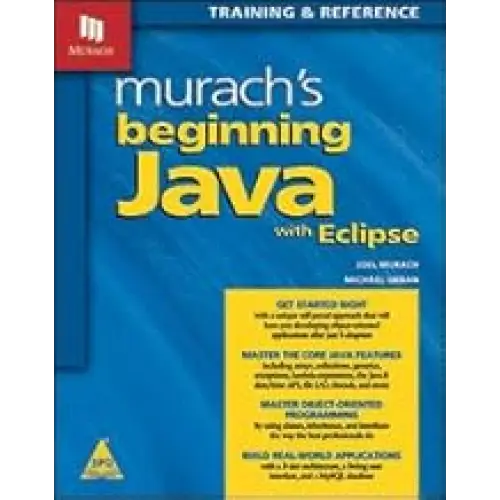BOOKZONE
Murach's Beginning Java with Eclipse
Paperback
by Joel Murach
SKU:9789352133215
Bulk Discount Get Exta 5% upto 10%
Share

What this book does
Section 1: Get started right
Section 1 presents a 6-chapter Java course that gets you off to a great start. This section works for complete beginners as well as experienced programmers because it lets you set your own pace. If you’re a beginner, you’ll move slowly and do all the exercises. If you have some experience, you’ll move more quickly and do the exercises that you choose.
From the start, you’ll be using the Eclipse IDE because that will help you learn faster. Then, by chapter 3, you’ll be developing applications that use classes from the Java API. By chapter 4, you’ll be developing object-oriented applications that use your own classes. By chapter 5, you’ll be using a 3-tier architecture to structure your object-oriented applications like a professional. And by chapter 6, you’ll be using the best practices for testing and debugging your applications.
Section 2: Expand your core Java skills
In section 2, you’ll expand upon what you learned in section 1 by mastering more of the core Java skills that you’ll use all the time. That means you’ll learn new skills, like how to work with strings and arrays. But you’ll also learn more about topics that were introduced in section 1, like working with primitive types and operators and coding control statements. These are the essentials that you need for section 3.
Section 3: Object-oriented programming made clear
This book has you creating simple object-oriented programs right from the start in section 1. Then, section 3 cuts through the mystery of inheritance, interfaces, polymorphism, and the factory pattern so you can learn how to create and use sophisticated business and data access classes. When you finish this section, you’ll know how to develop real-world, object-oriented, business applications.
Section 4: Take your core skills to the next level
Like section 2, section 4 lets you expand your core Java skills in new ways. To be specific, it teaches you how to work with collections, generics, lambdas, dates, times, exceptions, file I/O and threads. Because each chapter in this section is independent of the others, you can add these skills to your resume whenever you need them.
Section 5: Real-world GUI and database programming
When you complete sections 1-4, you’ll have all the Java skills you need to start learning web and Android programming. But there’s more!
The 4 chapters in section 5 introduce you to the skills that a professional Java programmer uses to develop desktop applications. To start, these chapters show you how to create a MySQL database for an application and how to write the Java code that works with the data in this database. Then, these chapters show how to develop a graphical user interface (GUI) for the application.
These chapters are designed to give you a better appreciation for what real-world Java programming is like, whether that be desktop, web, or Android programming. That, in turn, will help you decide what to learn next to build your Java career.


